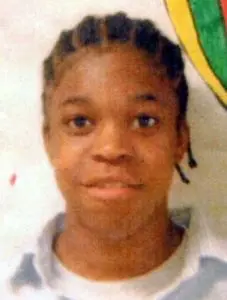
The Vanishing of Ivory Francis Green: A 17-Year-Old's Final Phone Call Home
When she called her mother later that night to say she was coming home for dinner on March 6, 2004, seventeen-year-old Ivory Francis Green had no idea those would be the last words her family would ever hear from her. What began as a typical teenage phone call home would mark the beginning of one of Utica, New York's most perplexing and enduring missing person cases.
A Normal Day Turns Into a Nightmare
Ivory was last seen at her home at the A Building of Washington Courts in Utica, New York at 4:00 p.m. on March 6, 2004. The teenager, described as 4'11" and 110 pounds with black hair and brown eyes, had left her apartment in the housing complex that afternoon. She left from Washington Court homes at 4 o'clock. It was in the winter time going to visit one of her friends.
For Ivory's mother, Shirlette Green-Smith, the evening began like countless others. She called me at 7:45 p.m. and told me she was on her way walking home. I said okay ivory i'll be waiting for you. I always kept a light in my kitchen, and i waited and waited and waited until daylight and no ivory.
The close relationship between mother and daughter made Ivory's disappearance all the more alarming. If she couldn't make it home she would call me and tell me I'm at such and such place and I may tell her you better get home or I'll call a cab for you. That's the relationship we had. We didn't have no relationship where she ranaway or nothing like that. Her mother's intuition was immediate and clear: "I know something had happened to her."
The Search Begins
The next day Mrs. Green-Smith continued to wait, but still no Ivory. She asked around to neighborhood if any one had seen Ivory, but no luck. Finally, she had to face her worst fears and report her daughter missing to the Utica Police Department.
Ivory had distinguishing characteristics that would make her recognizable. She has a mole above her upper lip and a mark in the shape of an H on her shoulder, along with a scar behind left ear. When she vanished, she was wearing baggy jeans, black winter coat, black baseball cap with a bandanna. Notably, she often wears boys' clothing and may be mistaken for a boy.
Initially, authorities treated the case as a runaway situation. She was going through a rebellious period at the time of her disappearance and was classified as a runaway for several years. When Ivory went missing, she was going through a "rebellious phase" and had run away before. However, her mother's certainty that this time was different would eventually prove prescient.
A Violent Twist
Two months after Ivory's disappearance, the case took a shocking and violent turn that would forever change the trajectory of the investigation. Two months after Ivory disappeared, Plummer Reed Jr., a distant relative of hers, called her mother and said he was going to tell her what had happened to Ivory. Before he could do so, however, he was shot three times in the head and the call disconnected.
The timing and circumstances of the shooting were no coincidence. Plummer survived his injuries. The attack on Reed sent shockwaves through the investigation and provided a clear indication that someone was willing to use extreme violence to keep Ivory's fate secret.
The perpetrators of the shooting were eventually brought to justice. His cousin, Benji D. Reed, was later sent to prison for the attempted murder. Another man, Marques Williams, was also charged with attempted murder but ultimately pleaded guilty to misdemeanor fourth-degree criminal facilitation and was sentenced to time served. Williams admitted to supplying Benji with the gun.
However, the violence achieved its intended effect of silencing potential witnesses. Since the shooting incident, Plummer has denied knowing anything about Ivory's disappearance. The brutal attempt to silence Reed demonstrated that someone had significant motivation to keep information about Ivory's fate from coming to light.
Theories and Investigation
By 2007, three years after Ivory's disappearance, authorities announced they believed she had been murdered. The investigation revealed troubling connections that may have put the teenager in danger. Ivory associated with a number of drug dealers in the Utica area, although she didn't herself sell drugs.
Investigators developed a theory about what might have happened to the teenager. It's theorized she willingly accompanied one of these people somewhere and that person harmed her. This theory suggests that Ivory may have trusted someone who ultimately betrayed that trust with fatal consequences.
Additional information emerged suggesting a possible motive for her disappearance. 2007 FBI investigators' belief that Green, then 17, was slain as retaliation against her cousin over the theft of drug money. This theory, if accurate, would make Ivory's death an act of revenge against her family rather than something she brought upon herself.
The Ongoing Investigation
Despite the passage of nearly two decades, law enforcement has not given up on Ivory's case. It's a case that we still actively investigate. We're still in contact with the victim's mother on a pretty much weekly basis we have really good solid leads in the case and we have for a long time. It's just none of those cases where we can't find her and evidence hasn't been presented to us or we haven't located evidence that would solidify a case for prosecution at this time.
The persistence of the investigation is noteworthy, with police say they have investigated more than 325 leads. This extensive investigation has yielded significant insights. Investigators believe they know what happened to her and they think they've already spoken to several people who know her whereabouts. Several of these individuals are currently incarcerated.
The fact that investigators believe they know what happened to Ivory but lack sufficient evidence for prosecution highlights the frustrating reality of many cold cases. Knowledge and proof are two very different things in the criminal justice system.
The Search Continues
Ivory may still be in upstate New York, possibly in Watertown, Syracuse or Auburn. She could also be in the Tryon, New York area. However, given that authorities announced they believed she had been murdered in 2007, any search for Ivory alive has likely shifted to a search for her remains.
Her mother says it is uncharacteristic of her to be out of touch with her loved ones. This sentiment has remained constant throughout the investigation and continues to drive the family's search for answers.
The case has received attention beyond local law enforcement efforts. Green-Smith also went to the National Center For Missing and Exploited Children in Utica and they created posters to share with the community. Ivory's photos can still be found hanging in Utica's Police Department, where they're still actively investigating her case.
A Mother's Unwavering Hope
For nearly twenty years, Shirlette Green-Smith has maintained her vigil for her daughter. For nearly 20 years, Shirlette Green has held out hope whoever knows what happened to her daughter, Ivory, would tell her, and give her the peace she so desperately needs.
The impact on the family extends far beyond the immediate loss. Every anniversary brings renewed pain and renewed hope for answers. It was eighteen years ago on Sunday that 17-year-old Ivory Green went missing from the City of Utica. Utica Police are still actively looking for information about her disappearance.
The persistence of both law enforcement and family in keeping Ivory's case active demonstrates the lasting impact of her disappearance on the Utica community. Despite a slow start to the investigation, investigators have tried to make up for lost time, spending years putting together the pieces that point toward the people responsible — people who refuse to talk, even 19 years later.
The Silence of Witnesses
One of the most frustrating aspects of Ivory's case is the apparent knowledge held by individuals who refuse to come forward. The violent attack on Plummer Reed demonstrated the lengths to which someone would go to maintain silence around Ivory's fate. This atmosphere of intimidation may continue to prevent witnesses from speaking out.
The fact that investigators believe they know what happened to her and they think they've already spoken to several people who know her whereabouts. Several of these individuals are currently incarcerated suggests that key witnesses may be more willing to speak now that they are removed from the street environment where intimidation was possible.
A Case That Refuses to Die
Her case remains unsolved. However, the active nature of the ongoing investigation and the dedication of both law enforcement and family members suggests that answers may still be possible. The combination of new forensic technologies, changing circumstances for potential witnesses, and the persistent pressure of an active investigation creates ongoing opportunities for breakthroughs.
The story of Ivory Francis Green represents more than just another missing person case. It illustrates the complex web of street-level drug activity, family relationships, and community silence that can surround such disappearances. It also demonstrates the enduring power of a mother's love and law enforcement's commitment to seeking justice, even decades after a crime.
Today, Ivory's photo is shown age-progressed to 35 years. She would now be in her late thirties, had she survived. Instead, her image remains frozen in time as a seventeen-year-old girl who made one final phone call home on a cold March evening, promising to return for dinner but never making it through the door.
The search for answers in Ivory Francis Green's disappearance continues, driven by a mother's unwavering love and investigators who refuse to let her case grow cold. Somewhere, someone knows what happened to Ivory on March 6, 2004. Until that person finds the courage to speak, Ivory's family and the Utica community will continue to wait for the truth about what happened to a teenager who simply wanted to come home for dinner.
Sources
- The Charley Project - Ivory Francis Green
- National Center for Missing & Exploited Children - Ivory Francis Green
- CUE - Community United Effort - Ivory Frances Green
- The Deck Podcast - Ivory Green
- International Missing Persons Wiki - Ivory Green
- Websleuths - Ivory Green
- The Polly Klaas Foundation - Ivory Green
- CNY Homepage - 16th anniversary of Utica teen's disappearance
- WIBX 950 - 18 Years Later, Utica Police Still Looking For Missing Teen
